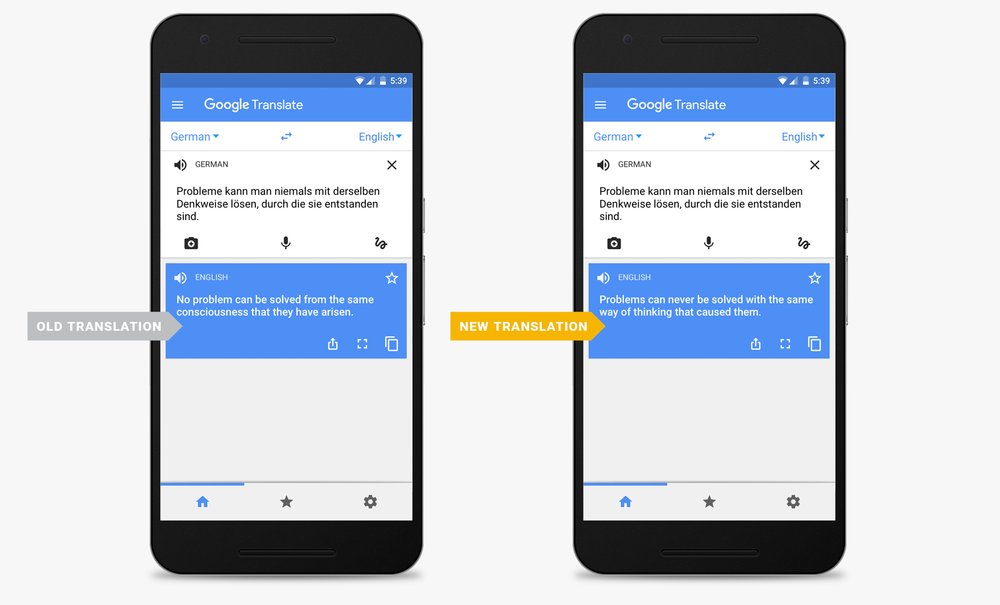Google Begins Using High-Accuracy Neural Machine Translation System For Eight Language Pairs
Recently, Google announced that it achieved near-human accuracy for translating to and from English, Spanish, and Chinese. The company is using a new neural network training technique, which it calls the Neural Machine Translation (NMT) system. Google announced today that it has started using its new system for nine languages (eight pairs) and that it will soon use it for all of Google Translate’s 103 supported languages.
Understanding Full Sentences
The main difference between Google’s previous ten-year-old Phase-Based Machine Translation system and the new Neural Machine Translation system is that it analyzes the sentence as a whole, rather than as the sum of its parts.
This adjustment means that Google’s new system can better understand the whole meaning of a sentence rather than just the meaning of a few words at a time, which it would then have to combine into a full sentence with less accurate results. Because it uses neural networks, the new system can also learn over time to create better and more natural translations.
A Big Leap In Machine Translation
Starting today, Google is enabling its Neural Machine Translation engine for eight language pairs. Google Translate users will be able to translate to and from English and French, German, Spanish, Portuguese, Chinese, Japanese, Korean and Turkish. According to Google, these language pairs represent the native language of a third of the world’s population, which covers more than 35% of Google Translate queries.
The company also noted that the progress it has made in translation accuracy with the new Neural Machine Translation system is bigger than what it achieved in the past ten years combined with the old phase-based system. Google will enable the new NMT system for the eight language pairs in the Google Translate app, the website, and Google Search. The company’s goal is to eventually enable the system for 103 languages.
Google also announced that its Google Cloud Platform service would begin to offer a translation API that also uses the new system.
Get Tom's Hardware's best news and in-depth reviews, straight to your inbox.
Lucian Armasu is a Contributing Writer for Tom's Hardware US. He covers software news and the issues surrounding privacy and security.
-
bit_user Replythe new Neural Machine Translation system is that it analyzes the sentence as a whole, rather than as the sum of its parts.
Only sentences? So, each sentence in a paragraph is translated apart from all the others? I guess it's a step in the right direction... It's explained here: https://www.youtube.com/watch?v=l2dVjADTEDU Worth watching, if only for his (albeit simplified) take on what a thought actually is.
Man, I hope they add dolphin and whale dialects, pretty soon.
Seriously, if there are any Douglas Adams fans out there, just think about how close we're coming to having social media arguments with all the non-English speakers of the world.Meanwhile the poor Babel fish, by effectively removing all barriers to communication between different cultures and races, has caused more and bloodier wars than anything else in the history of creation.
https://en.wikipedia.org/wiki/List_of_races_and_species_in_The_Hitchhiker%27s_Guide_to_the_Galaxy#Babel_fish -
Google Translate is getting really good. Now all that's left is to identify mistakes, so we can actually use it with confidence.Reply
Google Translate still can't cope with common mistakes, like "Allot of things". It does ask "did you mean: a lot of things?", but we wouldn't be asking for a translation if we knew. It also has difficulties noticing the relationship between two phrases if separated by a dot, like "I don't know. Do you?".
But it's a step in the right direction. Thumbs up for Google! -
johnsomedudedoe impressive considering most humans have trouble translating between two languages.. in fact some, most notably American, have trouble with just one language.. LOLReply
